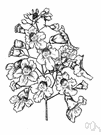catalpa
(redirected from catalpas)Also found in: Thesaurus, Encyclopedia.
Related to catalpas: Catalpa tree, Southern Catalpa
ca·tal·pa
(kə-tăl′pə, -tôl′-)n.
Any of various usually deciduous trees of the genus Catalpa of North America, the West Indies, and East Asia, especially C. bignonioides or C. speciosa of the United States, having large heart-shaped leaves, showy clusters of white flowers, and long slender pods.
[Creek katal̷pa : ka-, head + tal̷pa, wing (from the shape of its flowers).]
American Heritage® Dictionary of the English Language, Fifth Edition. Copyright © 2016 by Houghton Mifflin Harcourt Publishing Company. Published by Houghton Mifflin Harcourt Publishing Company. All rights reserved.
catalpa
(kəˈtælpə)n
(Plants) any bignoniaceous tree of the genus Catalpa of North America and Asia, having large leaves, bell-shaped whitish flowers, and long slender pods
[C18: New Latin, from Carolina Creek kutuhlpa, literally: winged head, referring to the appearance of the flowers]
Collins English Dictionary – Complete and Unabridged, 12th Edition 2014 © HarperCollins Publishers 1991, 1994, 1998, 2000, 2003, 2006, 2007, 2009, 2011, 2014
ca•tal•pa
(kəˈtæl pə)n., pl. -pas.
any of several trees of the genus Catalpa, of the bignonia family, native to North America and E Asia, having white flower clusters and long, beanlike seed pods.
[1720–30, Amer.; (< New Latin) < Creek katałpa <iká head + tałpa wing]
Random House Kernerman Webster's College Dictionary, © 2010 K Dictionaries Ltd. Copyright 2005, 1997, 1991 by Random House, Inc. All rights reserved.
ThesaurusAntonymsRelated WordsSynonymsLegend:
Switch to new thesaurus
| Noun | 1. |  catalpa - tree of the genus Catalpa with large leaves and white flowers followed by long slender pods catalpa - tree of the genus Catalpa with large leaves and white flowers followed by long slender podsgenus Catalpa - a dicotyledonous genus of plants belonging to the family Bignoniaceae; has large flowers (white or mottled) and long terete pods Catalpa bignioides - catalpa tree of southern United States Catalpa speciosa - catalpa tree of central United States bean tree - any of several trees having seedpods as fruits |
Based on WordNet 3.0, Farlex clipart collection. © 2003-2012 Princeton University, Farlex Inc.
